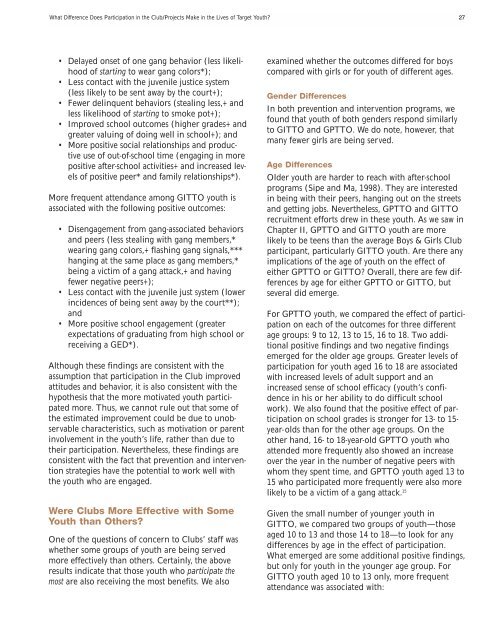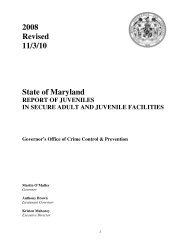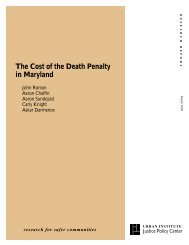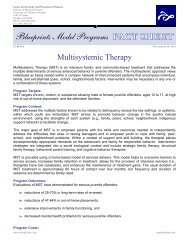Targeted Outreach - Governor's Office of Crime Control & Prevention ...
Targeted Outreach - Governor's Office of Crime Control & Prevention ...
Targeted Outreach - Governor's Office of Crime Control & Prevention ...
You also want an ePaper? Increase the reach of your titles
YUMPU automatically turns print PDFs into web optimized ePapers that Google loves.
What Difference Does Participation in the Club/Projects Make in the Lives <strong>of</strong> Target Youth? 27<br />
• Delayed onset <strong>of</strong> one gang behavior (less likelihood<br />
<strong>of</strong> starting to wear gang colors*);<br />
• Less contact with the juvenile justice system<br />
(less likely to be sent away by the court+);<br />
• Fewer delinquent behaviors (stealing less,+ and<br />
less likelihood <strong>of</strong> starting to smoke pot+);<br />
• Improved school outcomes (higher grades+ and<br />
greater valuing <strong>of</strong> doing well in school+); and<br />
• More positive social relationships and productive<br />
use <strong>of</strong> out-<strong>of</strong>-school time (engaging in more<br />
positive after-school activities+ and increased levels<br />
<strong>of</strong> positive peer* and family relationships*).<br />
More frequent attendance among GITTO youth is<br />
associated with the following positive outcomes:<br />
• Disengagement from gang-associated behaviors<br />
and peers (less stealing with gang members,*<br />
wearing gang colors,+ flashing gang signals,***<br />
hanging at the same place as gang members,*<br />
being a victim <strong>of</strong> a gang attack,+ and having<br />
fewer negative peers+);<br />
• Less contact with the juvenile just system (lower<br />
incidences <strong>of</strong> being sent away by the court**);<br />
and<br />
• More positive school engagement (greater<br />
expectations <strong>of</strong> graduating from high school or<br />
receiving a GED*).<br />
Although these findings are consistent with the<br />
assumption that participation in the Club improved<br />
attitudes and behavior, it is also consistent with the<br />
hypothesis that the more motivated youth participated<br />
more. Thus, we cannot rule out that some <strong>of</strong><br />
the estimated improvement could be due to unobservable<br />
characteristics, such as motivation or parent<br />
involvement in the youth’s life, rather than due to<br />
their participation. Nevertheless, these findings are<br />
consistent with the fact that prevention and intervention<br />
strategies have the potential to work well with<br />
the youth who are engaged.<br />
Were Clubs More Effective with Some<br />
Youth than Others?<br />
One <strong>of</strong> the questions <strong>of</strong> concern to Clubs’ staff was<br />
whether some groups <strong>of</strong> youth are being served<br />
more effectively than others. Certainly, the above<br />
results indicate that those youth who participate the<br />
most are also receiving the most benefits. We also<br />
examined whether the outcomes differed for boys<br />
compared with girls or for youth <strong>of</strong> different ages.<br />
Gender Differences<br />
In both prevention and intervention programs, we<br />
found that youth <strong>of</strong> both genders respond similarly<br />
to GITTO and GPTTO. We do note, however, that<br />
many fewer girls are being served.<br />
Age Differences<br />
Older youth are harder to reach with after-school<br />
programs (Sipe and Ma, 1998). They are interested<br />
in being with their peers, hanging out on the streets<br />
and getting jobs. Nevertheless, GPTTO and GITTO<br />
recruitment efforts drew in these youth. As we saw in<br />
Chapter II, GPTTO and GITTO youth are more<br />
likely to be teens than the average Boys & Girls Club<br />
participant, particularly GITTO youth. Are there any<br />
implications <strong>of</strong> the age <strong>of</strong> youth on the effect <strong>of</strong><br />
either GPTTO or GITTO? Overall, there are few differences<br />
by age for either GPTTO or GITTO, but<br />
several did emerge.<br />
For GPTTO youth, we compared the effect <strong>of</strong> participation<br />
on each <strong>of</strong> the outcomes for three different<br />
age groups: 9 to 12, 13 to 15, 16 to 18. Two additional<br />
positive findings and two negative findings<br />
emerged for the older age groups. Greater levels <strong>of</strong><br />
participation for youth aged 16 to 18 are associated<br />
with increased levels <strong>of</strong> adult support and an<br />
increased sense <strong>of</strong> school efficacy (youth’s confidence<br />
in his or her ability to do difficult school<br />
work). We also found that the positive effect <strong>of</strong> participation<br />
on school grades is stronger for 13- to 15-<br />
year-olds than for the other age groups. On the<br />
other hand, 16- to 18-year-old GPTTO youth who<br />
attended more frequently also showed an increase<br />
over the year in the number <strong>of</strong> negative peers with<br />
whom they spent time, and GPTTO youth aged 13 to<br />
15 who participated more frequently were also more<br />
likely to be a victim <strong>of</strong> a gang attack. 15<br />
Given the small number <strong>of</strong> younger youth in<br />
GITTO, we compared two groups <strong>of</strong> youth—those<br />
aged 10 to 13 and those 14 to 18—to look for any<br />
differences by age in the effect <strong>of</strong> participation.<br />
What emerged are some additional positive findings,<br />
but only for youth in the younger age group. For<br />
GITTO youth aged 10 to 13 only, more frequent<br />
attendance was associated with:

















